| dc.contributor.advisor | Stray, Anne | |
| dc.contributor.advisor | Bryhn, Anne | |
| dc.contributor.author | Verpe, Hans Henrik | |
| dc.date.accessioned | 2021-08-24T09:25:05Z | |
| dc.date.available | 2021-08-24T09:25:05Z | |
| dc.date.issued | 2021 | |
| dc.identifier.uri | https://hdl.handle.net/11250/2770908 | |
| dc.description.abstract | Hensikten med denne studien er å gjøre en teatervitenskapelig forankret undersøkelse av trylleforestillinger myntet på barn i kjernemålgruppa 4-7 år. Studien er et forsøk på å si noe om hva som kjennetegner og konstituerer denne forestillingstypen i teaterteoretisk forstand, gjennom å undersøke problemstillingen: Hva kan en teaterteoretisk analyse av egne barnetrylleforestillinger bidra med å si om denne uttrykksformens egenart og potensiale? Det metodiske rammeverket for prosjektet er et feltarbeid bestående i å granske egne trylleforestillinger for nevnte målgruppe gjennom intro- og ekstrospektiv observasjon i spilløyeblikket, refleksjon-i-handling, refleksjon-over-handling, feltdagbok og en overordnet hermeneutisk spiralreise mellom praksisutøvelsen i feltet på den ene siden, og undersøkelse av relevant teori og litteratur på den andre. Studien har et særlig fokus på uttrykksformens sterke interaktive beskaffenhet, og sentrale teoretikere som er med å utgjøre bakteppet for undersøkelsen er derfor Erika Fischer-Lichte, Siemke Böhnisch, Gareth White og Brian Way. Studien viser at teaterteoriens begrepsapparat er særlig godt egnet til å si noe om barnetryllingens vesen så vel i beskrivende som forklarende forstand | en_US |
| dc.description.abstract | The purpose of this study is to do a theatre scientifically anchored examination of magic performances aimed at children in the core target group of 4-7 years. The study is an attempt to identify what it is that characterizes and constitutes such performances in a theatre theoretical sense, by investigating the following research question: What can a theatre theoretical analysis of one’s own children’s magic performances help to say about the distinctiveness and potential of this form of expression? The methodical framework of this task is a field work consisting of scrutinizing my own magic performances for said target group by means of introspective and extrospective observation at the moment of performance, reflection-in-action, reflection-on-action, field diary and an overarching spiraling hermeneutical voyage between field practice on the one side, and examination of relevant theory and literature on the other. The study has a special focus on the strong interactive nature that characterizes children’s magic, and central theorists that make up the backdrop of the examination are thus Erika Fischer-Lichte, Siemke Böhnisch, Gareth White and Brian Way. The study shows that theatre theoretical terminology is particularly useful in saying something about the essence of children’s magic both in terms of description and explanation. | en_US |
| dc.language.iso | nob | en_US |
| dc.publisher | OsloMet - storbyuniversitetet | en_US |
| dc.relation.ispartofseries | MEST;2021 | |
| dc.subject | Teater | en_US |
| dc.subject | Tryllekunst | en_US |
| dc.subject | Trylling | en_US |
| dc.subject | Barneteater | en_US |
| dc.subject | Teatervitenskap | en_US |
| dc.subject | Publikum | en_US |
| dc.subject | Interaksjon | en_US |
| dc.title | Hokus Pokus! En teaterteoretisk analyse av trylleforestillinger for barn | en_US |
| dc.type | Master thesis | en_US |
| dc.description.version | publishedVersion | en_US |
